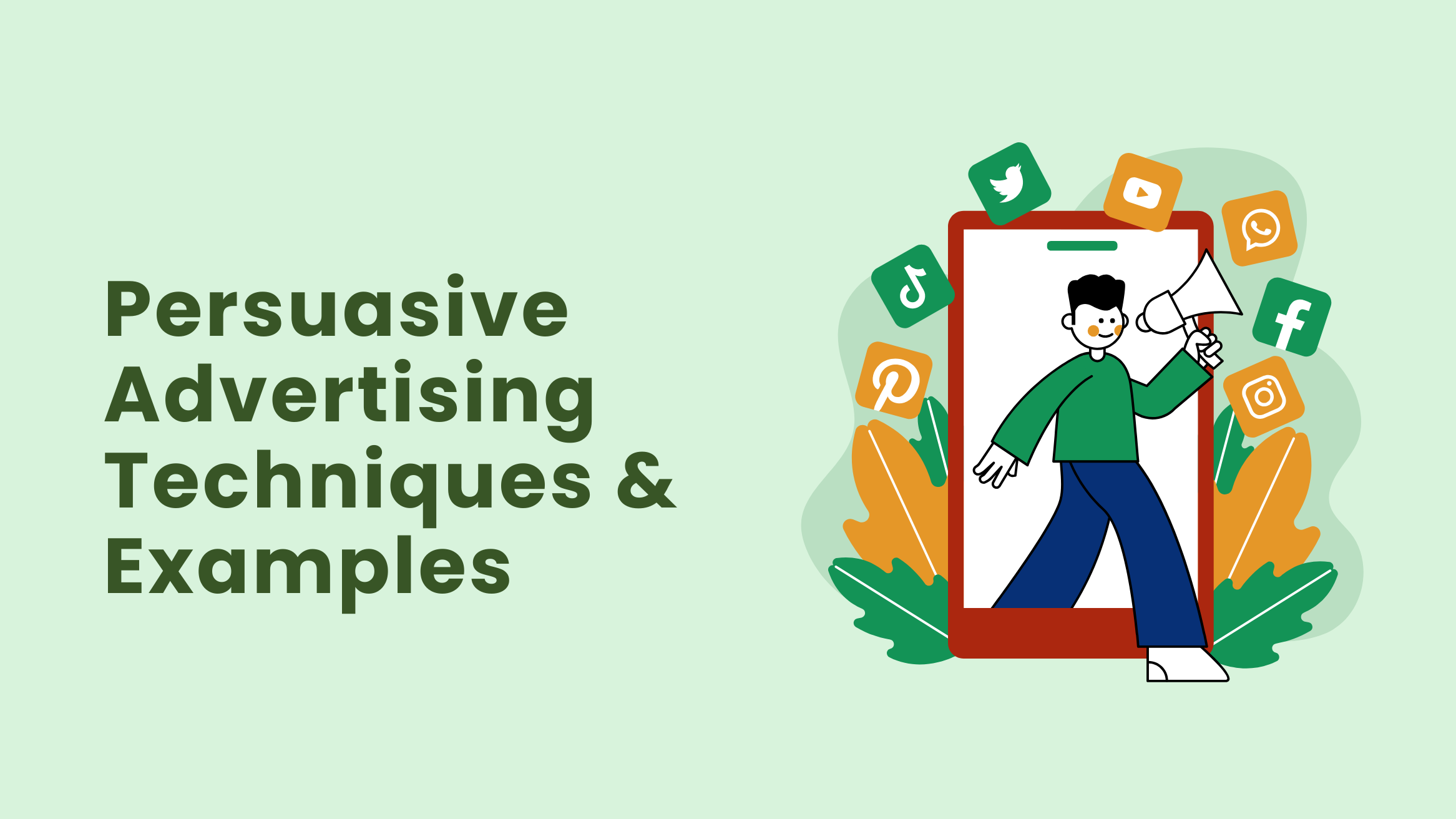
17 Persuasive Advertising Techniques & Examples to Boost Sales

Creating ads that genuinely resonate with audiences is a common struggle for many ad creators. You must use persuasion in your ads to stand out with a unique and heartwarming message. That’s why, today, I will discuss persuasive advertising techniques with some brilliant examples that will always come in handy.
Top Persuasive Advertising Techniques
- The Carrot: Offers features as irresistible benefits.
- The Stick: Uses fear of loss.
- Bandwagon Appeal: Encourages joining the crowd.
- Association: Links product to positive emotions.
- The Scarcity Principle: Creates urgency and FOMO.
- Transfer: Links product with desirable qualities.
- Humor: Engages with entertaining content.
- Appeal to Logic: Uses facts and data.
- Repetition: Reinforces message through repetition.
- Magic Ingredients: Highlights unique features.
- Snob Appeal: Targets exclusive, high-status consumers.
- Plain Folk: Appeals to everyday people.
Read on to explore other unique persuasion techniques.
Leveraging these techniques can help you design compelling campaigns that engage and captivate your audience. Persuasive advertising uses emotional appeals, credibility, data, and rhetorical persuasions in many forms to influence consumer behavior, making it a vital tool in marketing for driving brand success.
Table of Contents
Types of Persuasive Advertising Techniques and Examples
Ready to boost your advertising strategy with popular ad techniques examples? Let’s dive into my top 17 picks for the most persuasive advertising techniques that brands can’t get enough of. I will introduce you to these game-changing strategies and throw some jaw-dropping persuasive advertisement examples to ignite your creative spark and help you nail the right approach.
From bandwagon appeals to avant-garde themes, these persuasive advertising examples are like the Avengers of advertising – each one brings something powerful to the table. Get inspired and make your ads as compelling as a binge-worthy Netflix series. Start with the very common “the carrot” advertising technique!
1. The Carrot
What is the carrot in advertising? Simply put, horses love carrots, right? So, when you show them carrots, they become fond of you, creating an emotional connection for providing them with what they love. Some examples of persuasive advertising sometimes use the carrot and stick approach to stir strong emotions.
Just like using a juicy carrot to lure in a rabbit, you can attract buyers by showcasing your best deals, values, and offers. Think of the “carrot” as the excellent benefits your customers will reap from using your products or services. It’s all about dangling that irresistible incentive to get them hooked. Remember, everyone loves a good deal, and by highlighting these values, you’re making it easy for them to see why they need what you’re selling.
DocHipo offers numerous advertisement posters that leverage the carrot theory in persuasion. You can effortlessly transform features into valuable benefits your customers desire. Here’s an example to illustrate this approach.

Get This Template and More
Also, check out the beauty graphic design poster that uses rhetorical expressions to show your offers to your customers.
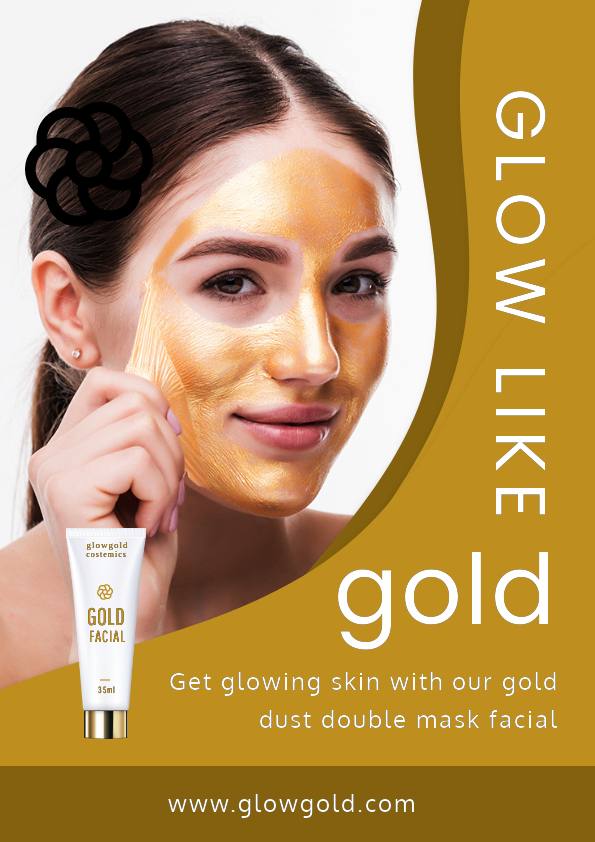
Get This Template and More
Example

L’Oréal Paris is raving about their new skincare product, promising glass-like, glowing skin in just a week! So basically, it shows how the users will enjoy the quickest skin rejuvenation like a secret spell; only it’s supported by clinical trials as well! If you’re searching for a top-notch anti-aging solution or a quick hydration boost, this might instantly become your holy grail. It is the power of persuasive advertising techniques in our daily lives.
2. The Stick
Ever heard of the “Stick and carrot analogy”? It’s a classic way to motivate purchasing behavior, and it’s everywhere in the examples of persuasive ads.
By now, you already know the meaning of carrot approach; it’s all about dangling a juicy reward in front of your audience.
Now, flip the coin, and you have the “stick theory.” It indulges the fear of a significant loss if you ignore the particular product or service. It may play with FOMO in your brain or make you uneasy about not reaping the benefits of the brand. It’s like saying, “If you don’t use our product, you’ll miss out big time!” The potential loss can be a powerful motivator.
So, when you’re checking out brands for persuasion in ads, notice the stick vs the carrot approach. Brands either entice you with irresistible perks or highlight what you’ll lose out on if you ignore their offer.
Here’s a stunning food Facebook ad template that perfectly illustrates the appeal of the stick theory. It effectively creates a sense of urgency, encouraging buyers to act quickly and not miss out on this affordable dessert deal!
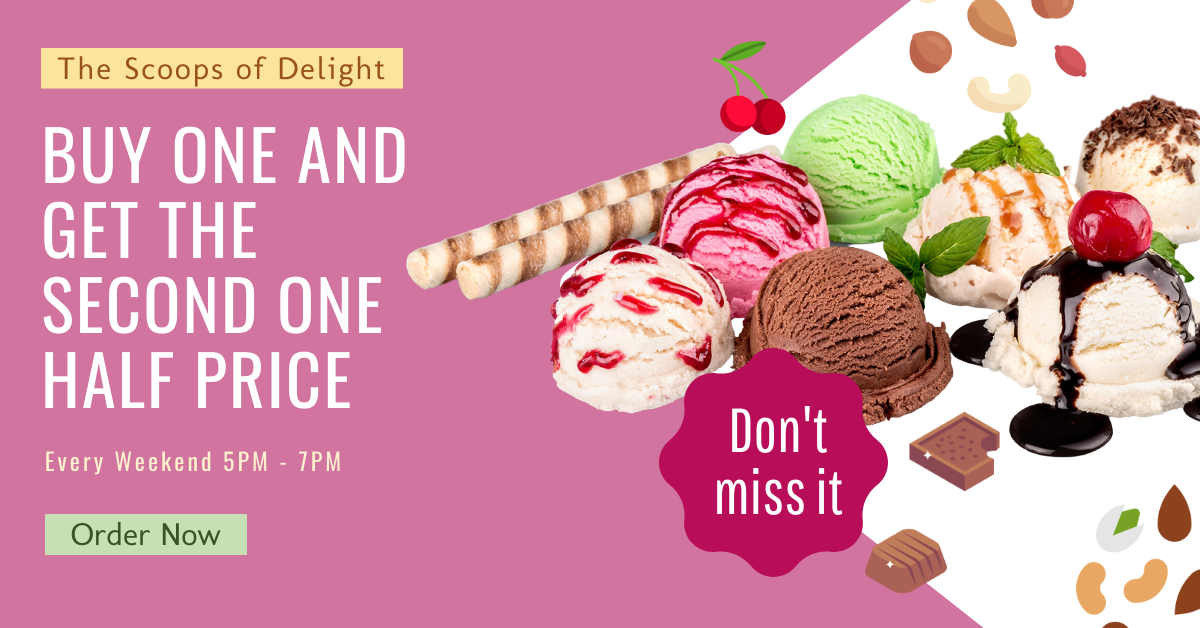
Get This Template and More
Example

Lakme’s 9 to 5 range creates this compelling ad that highlights the durability of their makeup, designed to last as long as your workday. The ad uses a classic carrot-and-stick approach, demonstrating the long-lasting effectiveness of the 9 to 5 products while contrasting it with other employees who need quick touch-ups at 5 p.m. This ad effectively communicates that with Lakme’s 9 to 5 range, you can enjoy long-lasting freshness without needing to carry makeup for touch-ups.
3. Bandwagon Appeal
Let’s start with the basic question, “What is the bandwagon technique?” The bandwagon effect capitalizes on the idea that people like to follow the crowd. By suggesting that “everyone is doing it” in your visual advert, you can persuade individuals to join in the same experience to avoid feeling left out.
Bandwagon fallacy in advertising is as common as your morning coffee! So, “How do you identify a bandwagon?” Bandwagon bias is so well-rooted in our lives that you don’t need to spend a second searching for a bandwagon effect example! It’s a typical example of the bandwagon effect when we support a team or cause only because it is popular or seems to win rather than because we genuinely believe in it.
And as an ad creator, you might also want to know, “How does social media use bandwagon appeal?” Social media ads also use the bandwagon appeal by showcasing popular trends and viral posts to encourage users to join in and participate, just like when a new song on TikTok or Instagram quickly spreads as everyone starts posting with that one viral hit. Ads use such audio to tune in with their audiences and inspire more people to join in the same experience as a relay race.
This travel Instagram ad template might be an excellent starting point if you want to create highly engaging social media ads with a bandwagon effect. Its compelling copy and vivid imagery target the collective mindset, encouraging viewers to explore the world just like everyone else!

Get This Template and More
Example

McDonald’s has always been a hit with the young crowd, offering more than just delicious fast food. Every bite brings back friendships, fun times, and unforgettable moments. This ad perfectly showcases the bandwagon effect, featuring Young Miko and a vibrant display of youthful energy and kickback stories. It is as if McDonald’s is saying, “Don’t you want to have a blast with your friends too?” I’m sure you feel like grabbing your Amigos and heading to McDonald’s for some good times.
4. Association
Alright, let’s talk about a foolproof visual advertising technique: the association principle in advertising. What is association technique? It’s when you link your product to a positive vibe, emotion, or image, even if it doesn’t directly connect with your product. This persuasive technique mainly relies on witty, persuasive writing and visual aids.
Wait, doesn’t it sound metaphorical? Then, what is visual metaphor in advertising? It’s the same! A visual metaphor in advertising also uses imagery to convey a message or representation by using two unrelated things.
How about this visual metaphor example?
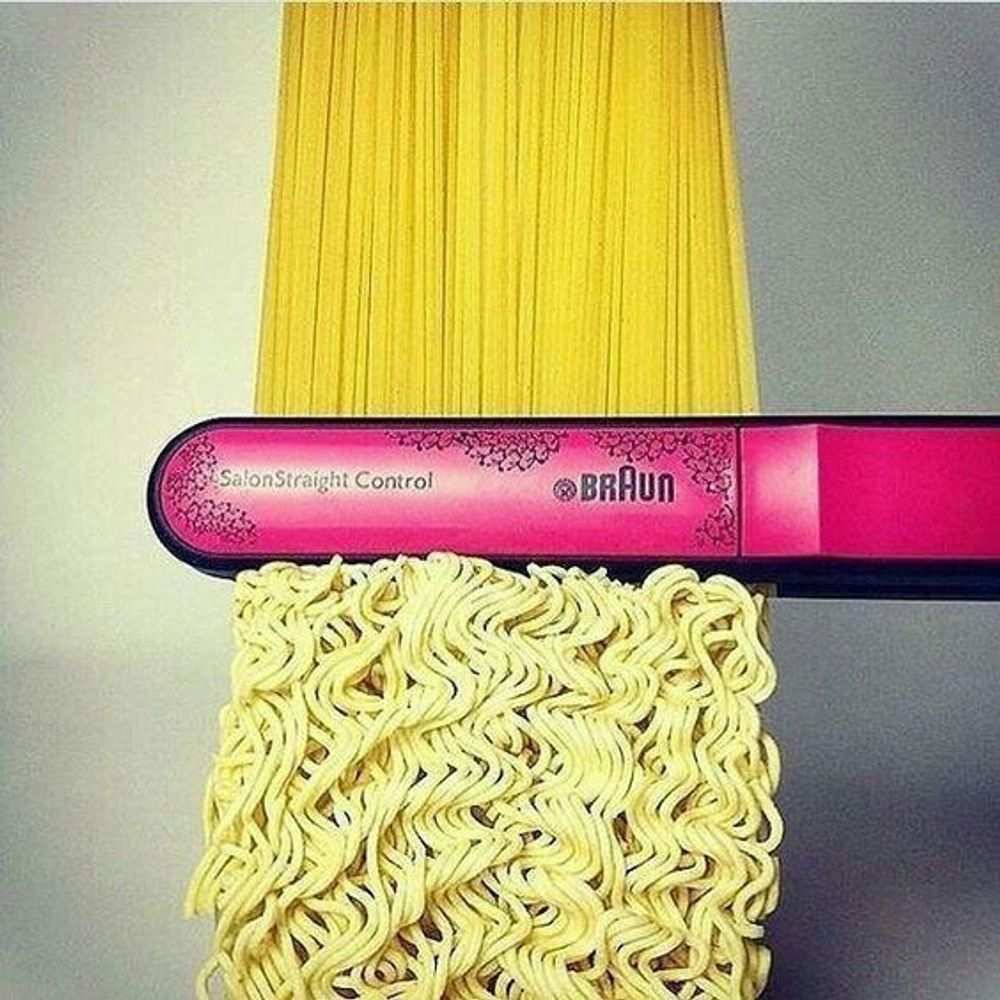
Braun is a famous brand for epilators, razors, and hair grooming products. In this visual metaphor example in advertising, Braun swaps out hair for noodles to highlight their hair straightener’s magic.
Another type of persuasive association method is celebrity association! Ever wonder why brands love using celebrities? It’s simple: we all want a piece of that glam life! When a famous personality endorses something, it looks way more appealing. Imagine scrolling through Instagram and seeing your favorite actor rave about a new skincare line. Suddenly, you want it too!
But how does association work in advertising? Creating a likable emotion associated with your product or service creates a desirable brand image, making consumers more likely to buy the product because they connect with the appealing qualities of the associated elements.
Example
What is the power of association in advertising? To help you understand this, I have two examples of association persuasive advertisements from the same brand for you! Let’s go one by one.

Heinz Ketchup and Ed Sheeran bring back the calm feeling of enjoying your authentic self with real taste! In Ed’s Heinz Ad, the charming Ed Sheeran transforms a simple dining moment into an unforgettable endorsement, showing the magic of celebrity association. By subtly linking Heinz Ketchup to Ed’s relaxed, relatable vibe, the ad leaves the audience craving a taste of that same down-to-earth coolness. Heinz becomes your all-time favorite!
Here’s another advert example for Heinz Ketchup that will blow your mind.
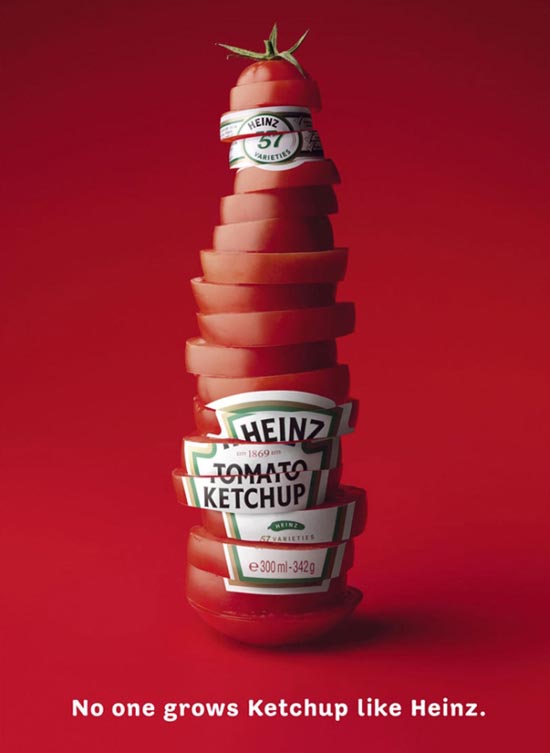
What do you see in it? Heinz expertly crafts its ad poster to reveal what’s really inside its iconic bottle. Slices of juicy, fresh tomatoes cleverly highlight that its ketchup is packed with real, farm-fresh goodness. This innovative association with fresh tomatoes isn’t just a gimmick; it resonates with families everywhere.
5. The Scarcity Principle
When you want the best example of persuasive advertising techniques, this method is a must for edgy ad creators like you. Let’s talk about: What is scarcity appeal?
Ever notice those “Limited Time Only!” or “Only 5 Left in Stock!” ads? That’s the Scarcity Appeal at work. This strategy, a favorite among marketers, creates urgency by making you feel like you need to act fast. Whether it’s limited quantities or a ticking clock, the goal is to push you to buy now rather than later. It’s all about leveraging FOMO (Fear of Missing Out).
What are the advantages of scarcity appeal? The Scarcity appeal works wonders for products or sales that are limited-time or in short supply. This type of persuasion in advertising is gold when promoting time-sensitive items like concert tickets or limited-edition goods. It creates urgency, making people feel they’ll miss out if they don’t act fast. So, when you want to create a buzz and get people scrambling, play up the scarcity angle and watch the magic happen.
If you also want to create ads with scarcity appeal, try DocHipo templates. Here’s a sneak peek of a Black Friday Facebook ad with a big blast of FOMO inside the message to lure people to take action immediately.
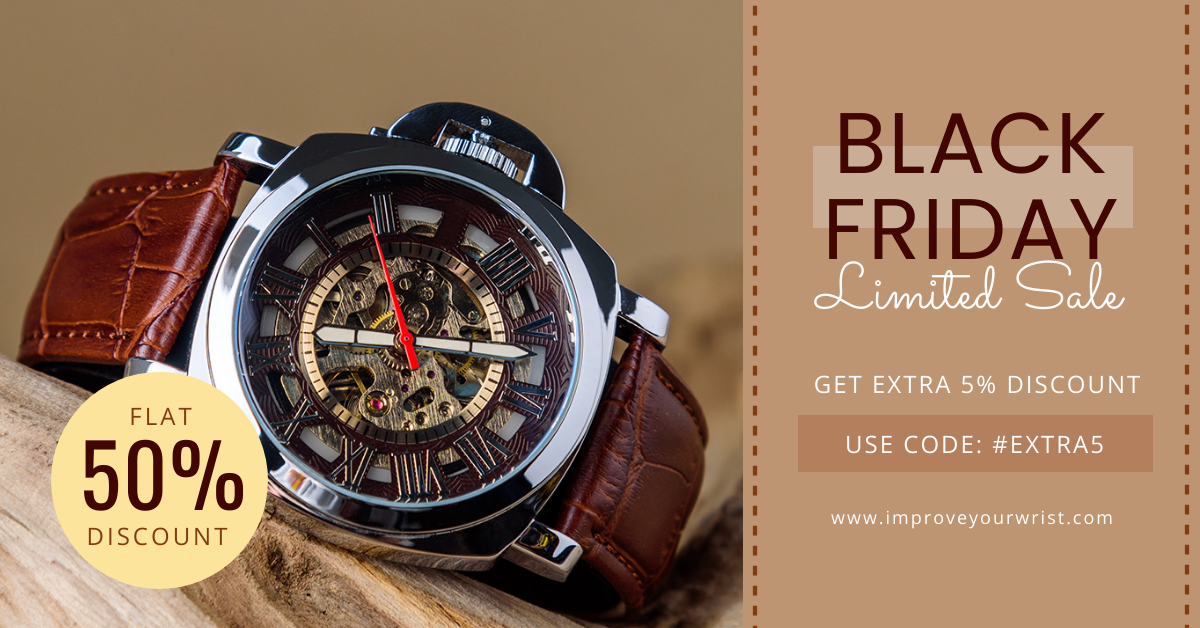
Get This Template and More
Example

Check out this ad! It’s a classic “now or never” marketing case designed to make you act fast. Playing the scarcity card pushes you to snap up the deal before it’s gone. With bold discounts and flashy incentives, it’s all about creating a major FOMO. Just like the old saying, “Strike while the iron is hot,” this ad uses urgency to get you to make that purchase immediately.
6. Transfer
Ever think about a unique personality and realize those particular traits resonate with you, creating a more profound sense of connection and belonging? That’s the basic example of the transfer fallacy.
Let’s talk from a marketer’s perspective: What is transfer advertising? Transfer advertising, a subtle yet powerful marketing technique, is a clever way to associate a brand with a desirable attribute, value, or emotion by linking it to a well-known entity, such as a celebrity, event, hyped experience, or idea, that already possesses strong quality and credibility.
Transfer ad examples are based on the psychological principle of classical conditioning, where the positive feelings and associations evoked by the linked entity or feature are transferred to the brand, enhancing its image and credibility.
Isn’t that really smart? Still, you might wonder, “What is the use of transfer in advertising?” After all, the other persuasive techniques seem spot-on in conveying benefits and features in a way that immediately stirs emotions! Well, the use of transfer in advertising is multifaceted. It allows brands to tap into the linked entity’s existing goodwill, nostalgia, or prestige, thereby increasing brand awareness and recognition and, ultimately, driving sales.
Example

Heinz’s latest ad campaign is one of the best examples of transfer in advertising! They’ve brilliantly tapped into the AI craze. It starts by showcasing AI’s cool new features, like text-to-image generation. Then, in a genius move, Heinz links this tech to their ketchup, showing how AI envisions a ketchup bottle. And just like that, Heinz nails the moment marketing game, building trust and a positive buzz. They’re riding the wave of what everyone’s obsessed with right now—AI! It is the art of transfer propaganda.
Clearly, Heinz has mastered the art of persuasive advertising techniques by riding the latest trends, so I couldn’t resist sharing more of their groundbreaking ads.
7. Humor
Humor in advertising is a common practice. Who doesn’t love a good laugh? The magic of funny ads with humor is that people love sharing them. Your reach skyrockets with minimal effort when your audience shares these hilarious ads with their friends.
Brands often apply humor appeal in persuasive advertisements. Some popular companies that use humor in advertising are Pepsi, Old Spice, GM (General Motors), McDonald’s, and M&M’s.
Example

Persuasive commercials examples with puns always win hearts. The above example of persuasion advertising with puns and self-deprecating humor is often the best form of humor appeal.
Ads with puns? They’re pure gold! A great example of persuasion advertising is the Dr. Evil General Motors ad, where Austin Powers’ nemesis, Dr. Evil, hilariously declares he can’t be the world’s second-worst enemy behind climate change. He decides to save the planet first, then take over it with his evil power.
This kind of self-deprecating humor is a top-notch persuasion technique. If your brand’s got a not-so-great reputation, why not poke fun at yourself? Show your audience you’re in for the joke and working to improve. After all, as they say, “laughter is the best medicine” – even for a brand’s image!
8. Appeal to Logic
It’s one of the major persuasive advertising techniques used broadly to create trust in your brand. We know that the framework of persuasive ads depends on three facets: Pathos, Logos, and Ethos. I’ve discussed enough examples of persuasive ads using pathos, which appeals to emotion like humor, bandwagon effect, and scarcity principle, and ethos, which appeals to credibility or character like celebrity endorsement!
Now, we’ll explore the concept of logos, an appeal to logic in persuasive devices in advertising. An ad that uses logos will provide all the facts and figures you need to grasp what the product truly offers. You can use rhetorical appeal to logic with storytelling and visualization.
This Instagram post for pets noted down every feature that the brand offers. If you want cute and appealing pet ads for social media, check out DocHipo’s other templates.
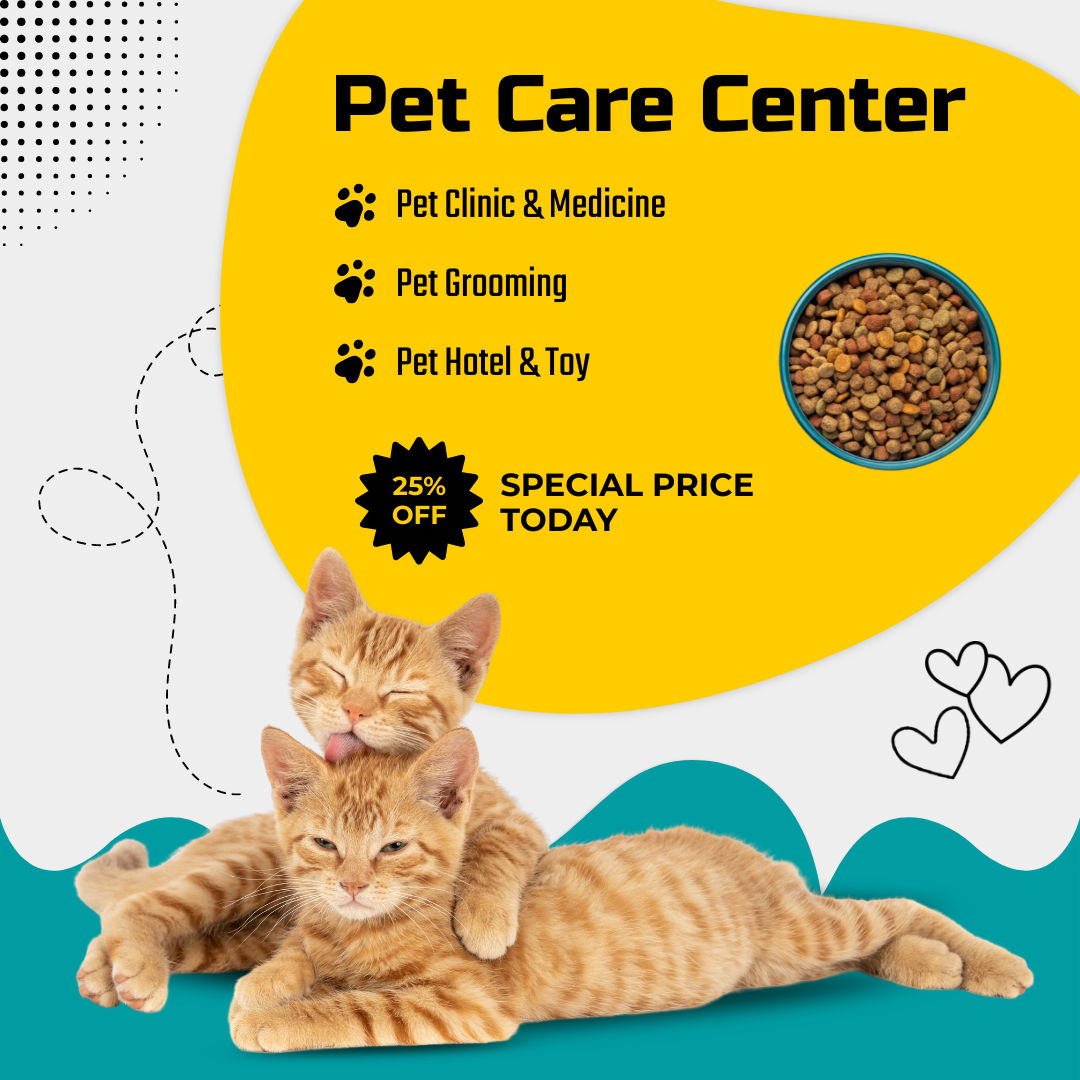
Get This Template and More
Example

The ad has killer visuals, top-tier production, and a track that really nails it. But the real appeal for persuasion? The logos appeal. What does it show? A sleek new phone, complete with a redesigned S Pen, an all-day battery, and a whopping one terabyte of storage with expandable memory.
Sounds like boring specs? Think again. In this slick commercial, those details pop. It’s pure logos appeal, hitting you right where it counts.
9. Repetition
Ever notice how repeating something a few times makes it stick in your brain like glue? That’s the power of repetition in advertising!
So, “What is the strategy of repetition?” By repeatedly showing your product name, slogan, images, or key message, you make sure it’s always on the audience’s mind. Whether within one ad or a whole series, repetition advertising keeps that message coming and watches your audience respond. They say, “The more you hear it, the more you believe it!”
Check out DocHipo’s restaurant flyer! It captures the sweet, deliciousness of cupcakes using repetition to tempt your taste buds.
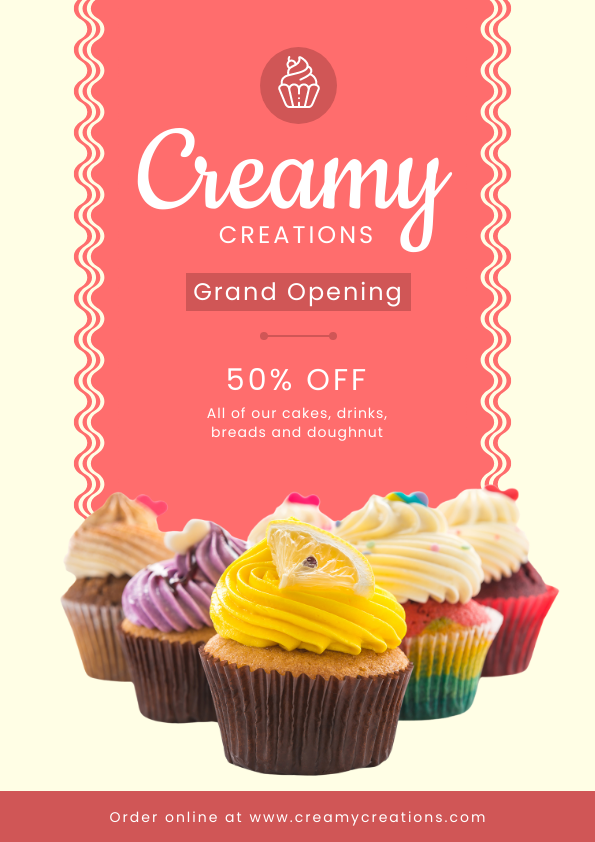
Get This Template and More
Example
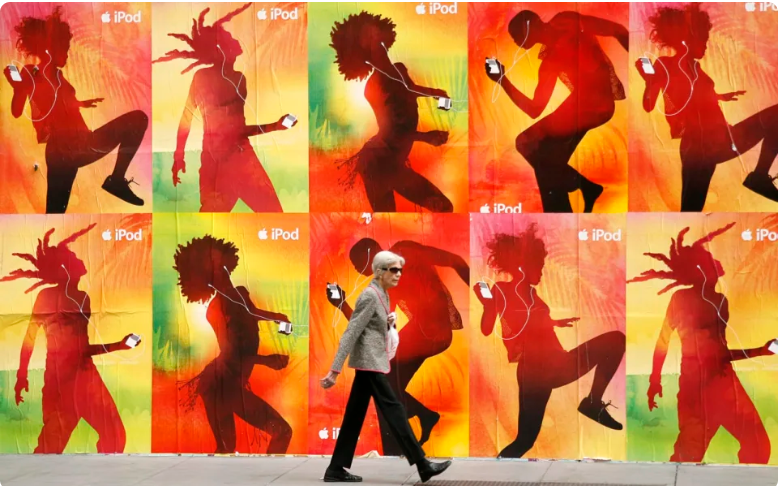
This ad keeps repeating a certain vibe. When you think of music, your mind goes straight to the iPod. Apple’s persuasive ad examples use this clever repetition of free-flowing visuals to etch its brand into your memory.
10. Magic Ingredients
Magic ingredients in advertising appeal with the suggestion that some miraculous discovery makes the product exceptionally effective. Pharmaceutical and skincare brands often use this persuasion method.
What is an example of magic ingredients? Imagine a top-notch pharmaceutical company boasting about its pain reliever’s special coating, which is gentler on your stomach than the competition’s.
Example

This Coca-Cola ad proves that hanging out with friends and turning an ordinary evening into something magical is as simple as sharing a bottle of Coke.
11. Snob Appeal
Being a snob might not always look cool, but as an ad creator, you will love making a snob appeal ad. What is snob appeal in advertising? When it comes to your product, examples of snob appeal in advertising are all about capturing that luxurious, glamorous lifestyle. Let’s be real – some folks love feeling elite. Some persuasive popular ads tapping into snob appeal create that exclusive vibe, attracting people who crave the superiority luxury items bring. Think of it like the ‘Great Gatsby’ effect – everyone wants a taste of the high life.
It can also appeal to those who crave standing out and feeling unique. Just look at the car sales ad for Instagram that draws in a crowd with a mindset of strong personality and distinctiveness.

Get This Template and More
Example

It’s one of the most popular snob appeal examples in advertising that speaks so loud within fifty seconds. The J’adore Dior perfume commercial oozes snob appeal, flaunting a luxurious vibe that not everyone can afford. This ad isn’t just selling a scent; it’s selling a lifestyle, aiming to set you apart from the crowd. Dior snob appeal advertisements use glamorous locations, stunning women in designer gowns, and dazzling jewelry.
12. Plain Folk
Now. let’s talk about the bread and butter of persuasive advertising techniques: the plain folk appeal. What is the plain folk technique?
Plain folks advertising is all about showing that a product is perfect for everyone. It aims to make products and services appealing and valuable to the average Joe. Think about it—who wants to buy something they’ll never use? Advertisers nail this by convincing us that their product is worth every penny. Imagine a family gathering around the dinner table, enjoying a specific cereal brand. It’s a scene we can all relate to, right? This kind of ad suggests that buying this cereal could help bring our own families together just like that.
It may sound familiar with the bandwagon effect in advertising. New ad creators often get confused for their strong appeal to the masses. So, what is the difference between plain folks and bandwagon?
The bandwagon effect works with the message: Everyone’s doing it, so why not you? Then there’s the plain folks approach, where speakers try to show they’re just like you and me with ideas that resonate with the everyday person. According to the plain folks appeal definition, to make a product appear practical and of good value, you should present it as being used by “ordinary” people. This technique uses broad, feel-good statements like “best quality” or “unbeatable performance” to appeal to universal values and beliefs. Though these claims might lack solid proof, they work wonders for everyday products and services, promising the best solutions and experiences.
The next LinkedIn banner for real estate packs a punch that everyone loves: the dream of owning a perfect home!

Get This Template and More
Example

The ad title, “It Starts with You,” perfectly captures how Starbucks has woven itself into the fabric of everyday life. Whether you’re a college student, a workaholic, or simply chilling with friends, Starbucks is your go-to spot.
13. Avant-garde Advertising
What is avant-garde in advertising? The avant garde ad is all about being ahead of the curve. It tells you, “Be the first!” and who doesn’t love that feeling? Think of Apple’s marketing as having the newest iPhone before everyone else simply makes you unique. Avant garde advertising makes customers feel like trailblazers, always ready to try something new or embrace the latest trends.
Example

This ad screams “avant-garde” like a trendsetter strutting down the runway. Get this car, and you’ll be miles ahead of the pack!
14. Bribery
Ever noticed ads promising a freebie if you buy something? That’s the classic “bribery” tactic in action. It makes you feel like you’re scoring a deal, and getting something free always gets marketers more store visitors.
Similarly, if you offer a lucrative discount on your product or service, you carefully incentivize your customers to take action. DocHipo’s Facebook ad templates can help you create such persuasive ads easily.
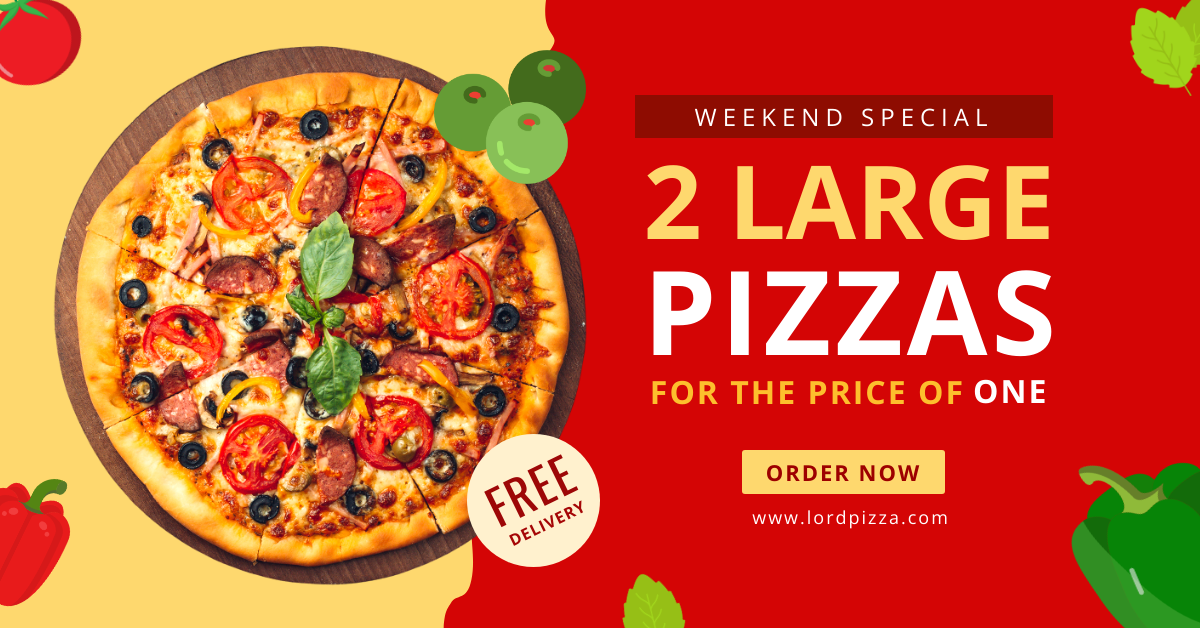
Get This Template and More
Example
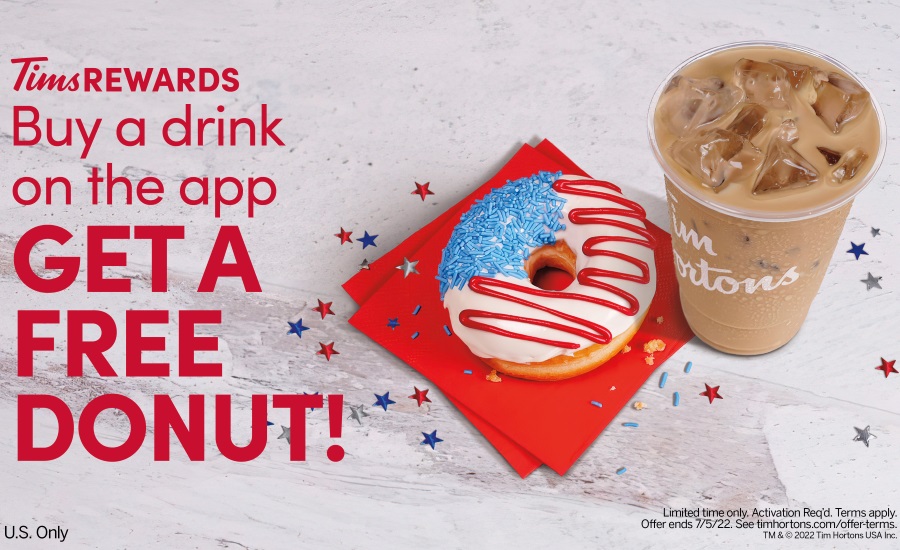
In my opinion, this ad really knows how to catch attention. Who doesn’t enjoy a good time on the 4th of July? Adding a free donut with special sprinkles to the mix just makes the deal even more irresistible. It’s definitely the kind of offer that’s hard to pass up.
15. Guerrilla Marketing
Okay, so now we will talk about the giant of persuasion – guerilla marketing! What is the concept of guerrilla marketing?
Guerrilla marketing is an unconventional and innovative marketing strategy that uses unconventional tactics and techniques to capture the attention of potential customers and create a lasting impression. The concept is an inspiration of guerrilla warfare tactics, where small and agile units of soldiers use surprise, ambush, and sabotage to defeat more significant, more traditional armies. Similarly, guerrilla marketing involves using creative, low-cost, and high-impact tactics to outsmart and gain an edge over larger, more conventional competitors.
It’s clearly a top-notch persuasive marketing tactic, but can you call it advertising? The most straightforward answer to your question: Is guerrilla marketing advertising? Absolutely! It can include everything from street teams, flash mobs, and viral videos to interactive events, pop-up installations, and experiential marketing campaigns. Guerrilla marketing aims to create buzz, generate word-of-mouth, and build a loyal customer following while staying within a limited budget.
Now, let’s learn: What are the 5 basic rules of guerilla marketing? Guerrilla marketing has five key principles: be creative, stay flexible, aim for surprise, engage emotionally, and focus on cost-effectiveness. These tactics help you make a significant impact with a small budget.
Example
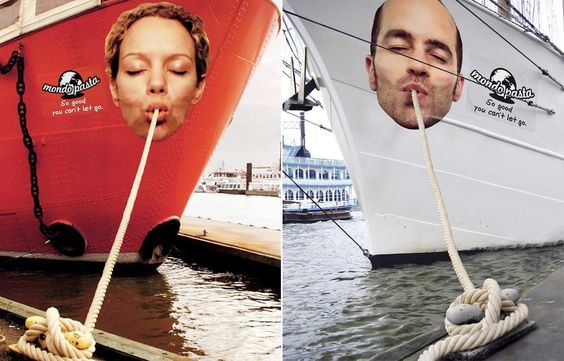
This perfect guerrilla marketing example takes an unconventional place for this unconventional approach. Mondo Pasta’s guerrilla marketing strategy involved a man and a woman slurping a noodle that was actually a rope tied to a dock. This unexpected persuasion advertising is both literal and imaginative, making it hard for the audience to look away.
16. Unexpected Settings
Using unexpected settings in advertising can be a powerful persuasion tool. By placing a product or message in an unusual or surprising context, you can grab attention and spark curiosity.
Example
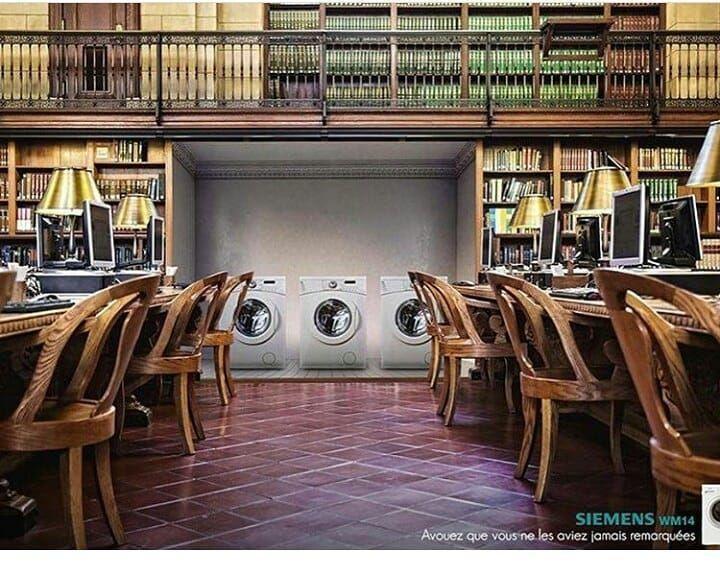
Siemens nails it with their clever ad, placing their washers and dryers in a library to showcase how quiet they are. It’s a brilliant way to highlight how peaceful and noise-free these appliances are.
17. Patriotism
Patriotism in advertising often means buying a product is a way to show your love for your country. For example, companies frequently boast about their products being made in America to tap into this sentiment.
Check out the 4th of July poster! This design is perfect to stir up patriotic emotions and boost sales all at once.
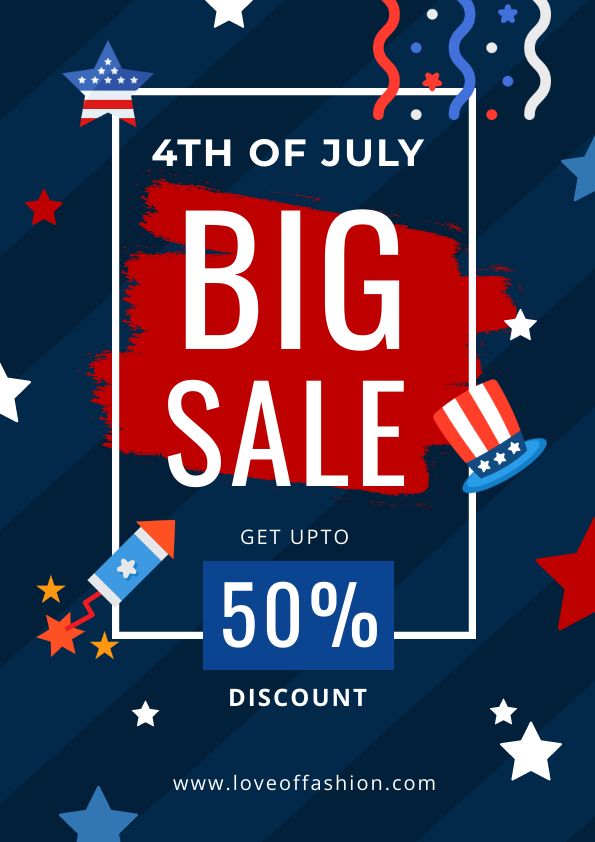
Get This Template and More
Example
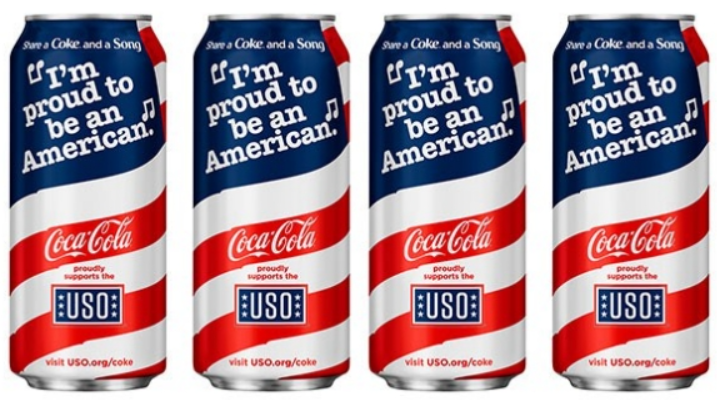
Coca-Cola hopped on the patriotic express with new red, white, and blue Coke cans, celebrating its 75-year partnership with the USO and honoring U.S. military members. These limited-edition, USA-themed cans hit stores just in time for Independence Day.
These persuasive advertising techniques will help you to create your next magnum opus in ad design creation.
How to Create a Persuasive Advertisement with DocHipo
If you’re new to creating ad masterpieces and often find yourself racing against tight deadlines, DocHipo is your ultimate solution. Here’s why:
DocHipo’s templates are explicitly organized, making it easy to find the perfect one for your ads based on document format, industry, or occasion.
Watch this video to see how easily you can find your desired templates.
Their extensive library includes flyers, posters, social posts, social media ads, leaderboard ads, large rectangle ads, and many other advertisement templates.
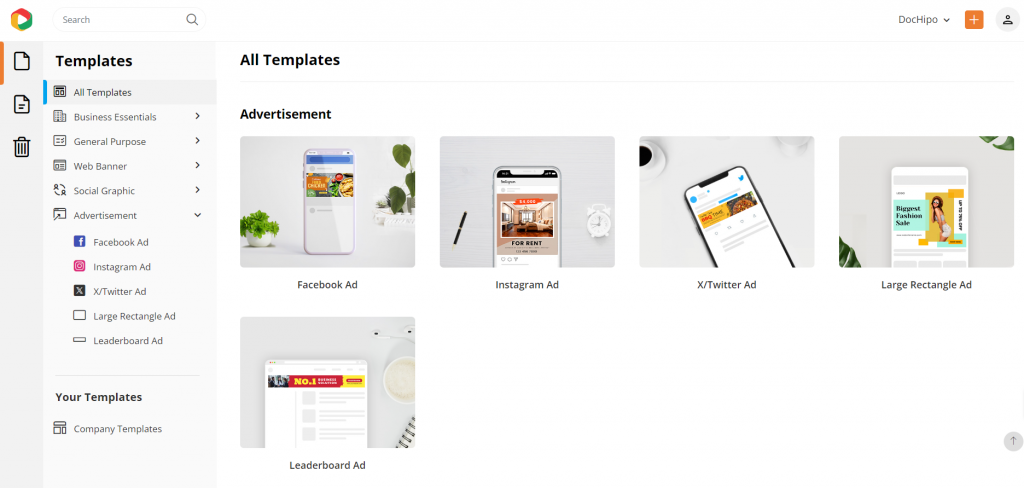
The best part? Customization is a breeze. With DocHipo’s resourceful widgets, design assets, AI background remover, AI writer and translator, and a host of bonus editing features like the latest photo editor with filters, unlimited free stock images, photo collages, and videos, you have everything you need to create standout ads. Follow these three easy steps: select a template, customize it as you want, and download or share your creation. Isn’t that easy?
Check out this video to easily find the right widgets to customize your design.
You can also easily create ads from scratch by uploading your files and editing them with rich and powerful tools.
With DocHipo, you’ll have everything you need to create stunning ads quickly and easily. Let’s get started with DocHipo.
Conclusion
To wrap things up, these persuasive advertising techniques can significantly enhance your marketing strategies, boosting your sales and brand visibility. Moreover, if you want to make trendy ads quickly, sign up for DocHipo today and explore our extensive range of ad design templates.
FAQ
What is persuasive advertising with an example?
Persuasive advertising aims to influence the audience’s beliefs or behaviors by using different types of persuasion depending on ethos, pathos, and logos theory. For example, an ad that encourages people to buy a product by highlighting its benefits is a famous persuasive technique, the carrot theory.
What is the most common persuasive technique?
The most common persuasive technique in advertising is the bandwagon bias. Advertisers use it to create the impression that their brand is trendy and widely loved, encouraging people to join in and feel part of the trend.
What is bandwagon?
Bandwagon is a persuasive technique that suggests everyone is doing or using something, so you should, too. It creates a sense of belonging and conformity.
Is the bandwagon good or bad?
The bandwagon technique can be both good and bad. It can create a sense of community and inclusivity but also lead to conformity without critical thinking. If the brand experience falls short, this technique can negatively impact brand equity.
What persuasive technique uses celebrities?
Persuasive advertising with celebrity associations or snob appeal often uses celebrities to endorse products or services, leveraging their influence and appeal to attract consumers.
What is testimonial technique?
The testimonial technique involves using personal stories or endorsements from satisfied customers or influential individuals to persuade the audience. It helps to build trust for your brand.
What is the rule of six in advertising?
The Rule of Six in advertising emphasizes that loyal customers are six times more likely to engage with your brand, pay attention to your marketing, think positively about your brand, make repeat purchases, try other products you offer, resist competitors’ offers, recommend your brand, and invest in it. This approach, validated across various markets, enhances brand profitability by fostering genuine customer loyalty, making it effective for B2C, B2B, and D2C brands.
What is fear appeal in advertising?
Fear appeal in advertising is a persuasive technique that aims to influence behavior by using fear to highlight the negative consequences of not taking a particular action. The carrot and stick method is overtly popular for this reason.
What is an example of transfer propaganda?
An example of transfer propaganda is when symbols, colors, or images associated with positive concepts are used to create a positive association with a person, product, or idea.


